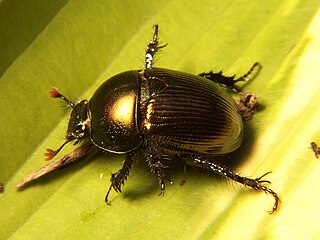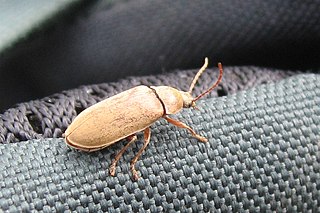| Dysidinae | |
|---|---|
 | |
| Apoleon edax | |
| Scientific classification | |
| Kingdom: | |
| Phylum: | |
| Class: | |
| Order: | |
| Superfamily: | |
| Family: | |
| Subfamily: | Dysidinae Lesne, 1921 |
| Genera | |
Dysidinae is a subfamily of beetles.
| Dysidinae | |
|---|---|
 | |
| Apoleon edax | |
| Scientific classification | |
| Kingdom: | |
| Phylum: | |
| Class: | |
| Order: | |
| Superfamily: | |
| Family: | |
| Subfamily: | Dysidinae Lesne, 1921 |
| Genera | |
Dysidinae is a subfamily of beetles.

Beetles are insects that form the order Coleoptera, in the superorder Endopterygota. Their front pair of wings are hardened into wing-cases, elytra, distinguishing them from most other insects. The Coleoptera, with about 400,000 described species, is the largest of all orders, constituting almost 40% of described insects and 25% of all known animal species; new species are discovered frequently, with estimates suggesting that there are between 0.9 and 2.1 million total species. Found in almost every habitat except the sea and the polar regions, they interact with their ecosystems in several ways: beetles often feed on plants and fungi, break down animal and plant debris, and eat other invertebrates. Some species are serious agricultural pests, such as the Colorado potato beetle, while others such as Coccinellidae eat aphids, scale insects, thrips, and other plant-sucking insects that damage crops.

The sap beetles, also known as Nitidulidae, are a family of beetles.

The family Scarabaeidae, as currently defined, consists of over 30,000 species of beetles worldwide; they are often called scarabs or scarab beetles. The classification of this family has undergone significant change in recent years. Several subfamilies have been elevated to family rank, and some reduced to lower ranks. The subfamilies listed in this article are in accordance with those in Bouchard (2011).

Tiger beetles are a family of beetles, Cicindelidae, known for their aggressive predatory habits and running speed. The fastest known species of tiger beetle, Rivacindela hudsoni, can run at a speed of 9 km/h, or about 125 body lengths per second. As of 2005, about 2,600 species and subspecies were known, with the richest diversity in the Oriental (Indo-Malayan) region, followed by the Neotropics. While historically treated as a subfamily of ground beetles (Carabidae) under the name Cicindelinae, several studies since 2020 indicated that they should be treated as a family, the Cicindelidae, which are a sister group to Carabidae within the Adephaga.

The insects of the beetle family Chrysomelidae are commonly known as leaf beetles, and include over 37,000 species in more than 2,500 genera, making up one of the largest and most commonly encountered of all beetle families. Numerous subfamilies are recognized, but the precise taxonomy and systematics are likely to change with ongoing research.

Passalidae is a family of beetles known variously as "bessbugs", "bess beetles", "betsy beetles" or "horned passalus beetles". Nearly all of the 500-odd species are tropical; species found in North America are notable for their size, ranging from 20–43 mm, for having a single "horn" on the head, and for a form of social behavior unusual among beetles.

The Haliplidae are a family of water beetles that swim using an alternating motion of the legs. They are therefore clumsy in water, and prefer to get around by crawling. The family consists of about 200 species in 5 genera, distributed wherever there is freshwater habitat; it is the only extant member of superfamily Haliploidea. They are also known as crawling water beetles or haliplids.

The longhorn beetles (Cerambycidae), also known as long-horned or longicorns, are a large family of beetles, with over 35,000 species described. Most species are characterized by extremely long antennae, which are often as long as or longer than the beetle's body. In various members of the family, however, the antennae are quite short and such species can be difficult to distinguish from related beetle families such as the Chrysomelidae. The scientific name of this beetle family goes back to a figure from Greek mythology: after an argument with nymphs, the shepherd Cerambus was transformed into a large beetle with horns.
Blue Beetle is the name of three fictional superheroes appearing in a number of American comic books published by a variety of companies since 1939. The most recent of the companies to own rights to Blue Beetle is DC Comics, which bought the rights to the character in 1983, using the name for three distinct characters over the years.

Polyphaga is the largest and most diverse suborder of beetles. It comprises 144 families in 16 superfamilies, and displays an enormous variety of specialization and adaptation, with over 350,000 described species, or approximately 90% of the beetle species so far discovered.

Harpalinae is a subfamily of ground beetles that contains more than 3,000 species in 4 tribes worldwide, according to the Carabcat Database. A rarely used common name for the subfamily is the harp beetles. The Harpalinae contain the most apomorphic ground beetles, displaying a wide range of forms and behaviors. Some are, rare among ground beetles, omnivores or even herbivores.

Staphyliniformia is a large infraorder of beetles. It contains over 70,000 described species from all regions of the world. Most species occur in moist habitats - various kinds of rotting plant debris, fungi, dung, carrion, many live in fresh water.

Scarabaeoidea is a superfamily of beetles, the only subgroup of the infraorder Scarabaeiformia. Around 35,000 species are placed in this superfamily and some 200 new species are described each year. Its constituent families are also undergoing revision presently, and the family list below is only preliminary.

The Chrysomeloidea are an enormous superfamily of beetles, with tens of thousands of species. The largest families are Cerambycidae, long-horned beetles, with more than 35,000 species, and Chrysomelidae, leaf beetles, with more than 13,000 species.

Blister beetles are beetles of the family Meloidae, so called for their defensive secretion of a blistering agent, cantharidin. About 7,500 species are known worldwide. Many are conspicuous and some are aposematically colored, announcing their toxicity to would-be predators.

Geotrupidae is a family of beetles in the order Coleoptera. They are commonly called earth-boring dung beetles or dor beetles. Most excavate burrows in which to lay their eggs. They are typically detritivores, provisioning their nests with leaf litter, but are occasionally coprophagous, similar to dung beetles. The eggs are laid in or upon the provision mass and buried, and the developing larvae feed upon the provisions. The burrows of some species can exceed 2 metres in depth.

Derodontidae is a family of beetles, in its own superfamily, Derodontoidea, sometimes known as the tooth-necked fungus beetles. Beetles of this family are small, between 2 and 6 mm in length, typically with spiny margins on their pronotum that give them their name, though the genus Laricobius lacks these spines. Unusual among beetles, they have two ocelli on the top of their heads.

The family Scraptiidae is a small group of tenebrionoid beetles sometimes called false flower beetles. There are about 400 species in 30 genera with a world-wide distribution. The adults are found on flowers, sometimes in large numbers, but are also found on foliage. The larvae are typically found under the bark of dead trees. The oldest fossils of the group date to the Eocene.

Dascilloidea is a superfamily of polyphagan beetles, comprising two families: Dascillidae and Rhipiceridae.

Coccinellidae is a widespread family of small beetles. They are commonly known as ladybugs in North America and ladybirds in Great Britain. Entomologists prefer the names ladybird beetles or lady beetles to avoid confusion with true bugs. Many of the species have conspicuous aposematic colours and patterns, such as red with black spots, that warn potential predators that they are distasteful.